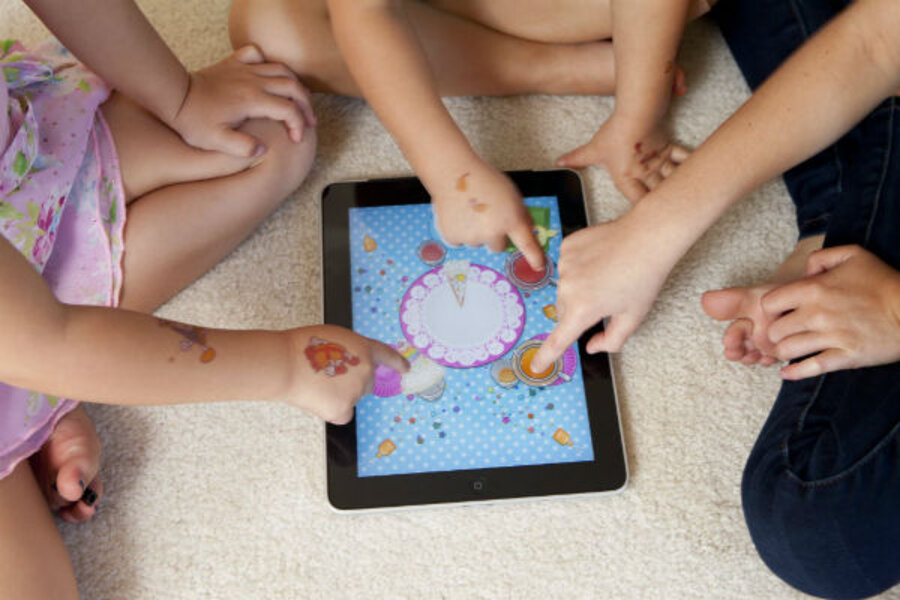Digital literacy: How soon should kids learn to use touch screens?
Loading...
This past month I spent a good bit of time interviewing parents for our magazine cover story this week, Toddlers on touch screens.
While most had some level of anxiety about their toddlers playing with touch screens (a number mentioned what child development experts call the “zombie effect,” that blank, unresponsive gaze toward back-lit devices) many also said that they felt they needed to let their young kids delve into mobile technology. After all, they said, this is the future. And nobody wants their kids to be "left behind" – especially not the parents within that demographic of Americans who can afford iPads.
But I was struck by the somewhat contradictory nature of this worry.
On the one hand, parents are almost universally amazed by the ease and rapidity with which their toddlers figure out how to use touch screens. Little ones are so naturally competent with swiping and scrolling that it doesn’t take long before they just zone out with the tablet – a rarity for an age group that usually demands constant attention. On the other hand, parents worry that if Junior doesn’t get a chance to exercise this digital inclination, he will end up trailing his iPad savvy peers.
Maybe he won’t perform as well on tests given (as they are in some districts) on touch-screen tablets. Maybe he won’t be involved in the Next Big Technological Thing. Maybe he’ll be the laughing stock of his peers when he reveals he doesn’t recognize the name “Angry Birds,” or even worse, “Duck Duck Moose.”
I asked educators and child development experts – including a number who are enthusiastic touch screen proponents – about all of this.
The overwhelming response from all sides of the iPads-and-toddlers debate? Parents can relax.
The sort of critical thinking that children might use to start the next great technological revolution develops not from using the technology of today, says Susan Linn, co-founder of the Campaign for a Commercial Free Childhood, but from hands-on play, interaction with parents, and good old 2-year-old exploration. After all, Steve Jobs didn’t grow up with an iPad.
“There just isn’t compelling evidence that screen time is necessary for young children,” she told me. The preschool at Google, she pointed out, is almost entirely screen free.
Those same aspects of tablet technology that makes it so easy for 2-year-olds to use means that children who don’t have iPads – and this includes much of the lower income population – will be quite able to catch up, she and others said.
Mary McFadden, a grandmother I spoke to for the piece, saw this “catching up” first hand. She has two grandchildren – Oliver, a 5-year-old, and Celia, who is almost 2. Oliver’s parents have long allowed him access to touch screens; these days he can pick up his parent’s iPad and play games whenever he wants. Celia’s parents, on the other hand, limit screen time, adhering to the American Academy of Pediatrics suggestion that children under 2 not be exposed to televisions, video games, iPads, and so on.
While Oliver is far more versed in the world of mobile app games, Ms. McFadden has been shocked at how equally competent Celia seems with the touch screen whenever she gets ahold of her grandmother’s phone. (Mom and Dad, McFadden says, make a grudging grandmother exception to the screen time rules, and she’s careful not to pull out Peek-a-Boo barn all that much.)
“Celia must have learned the swiping from watching her parents answer the phone,” McFadden says. “Now she knows you can push the off button and you get these other options. She figured it out immediately.”
The difference in Celia’s and Oliver’s access to the iPad, she suspects, will mean little down the road in terms of familiarity with the technology.
This isn’t to say that digital literacy isn’t important, educators agreed. But this sort of literacy is something that comes offline, grounded in the real world of communication.
This means the tough conversations between parents and children about social media, for instance, or learning how to recognize advertising hidden within the plot line of a game.
And it means, a number of child development experts suggested, that parents monitor their own mobile technology use – and keep educating themselves to understand (and then talk about) the off-line dilemmas their touch-screen savvy children might be entering in the iPad world.






